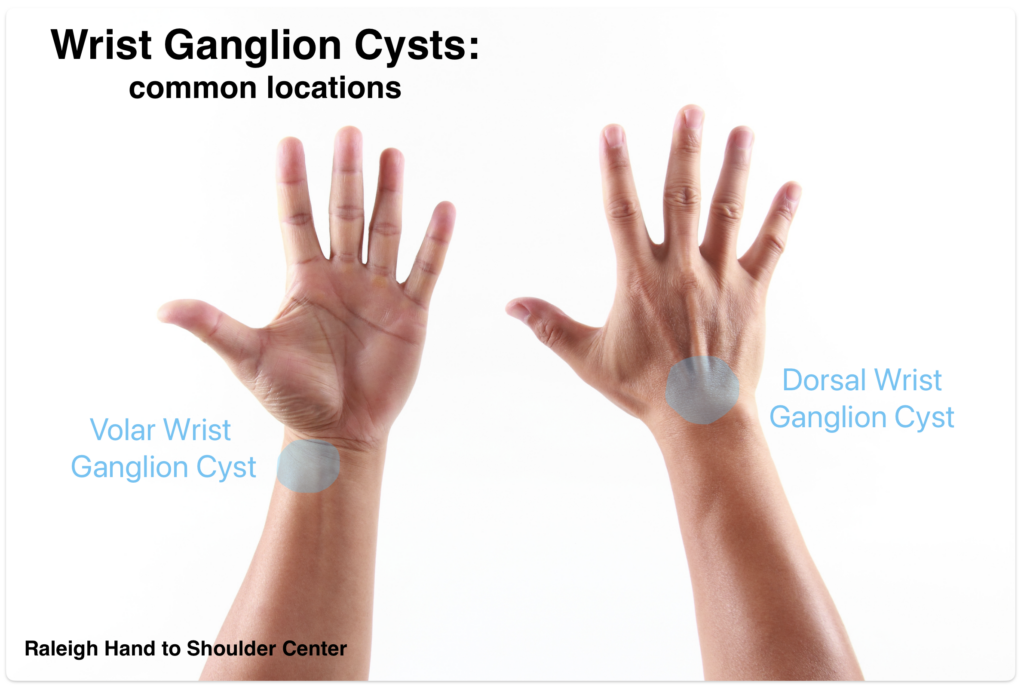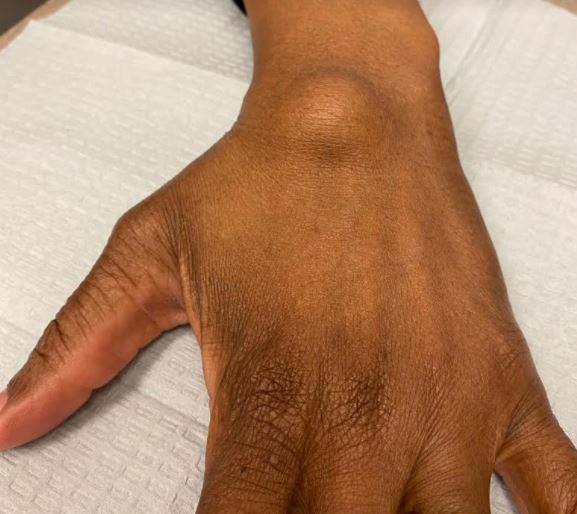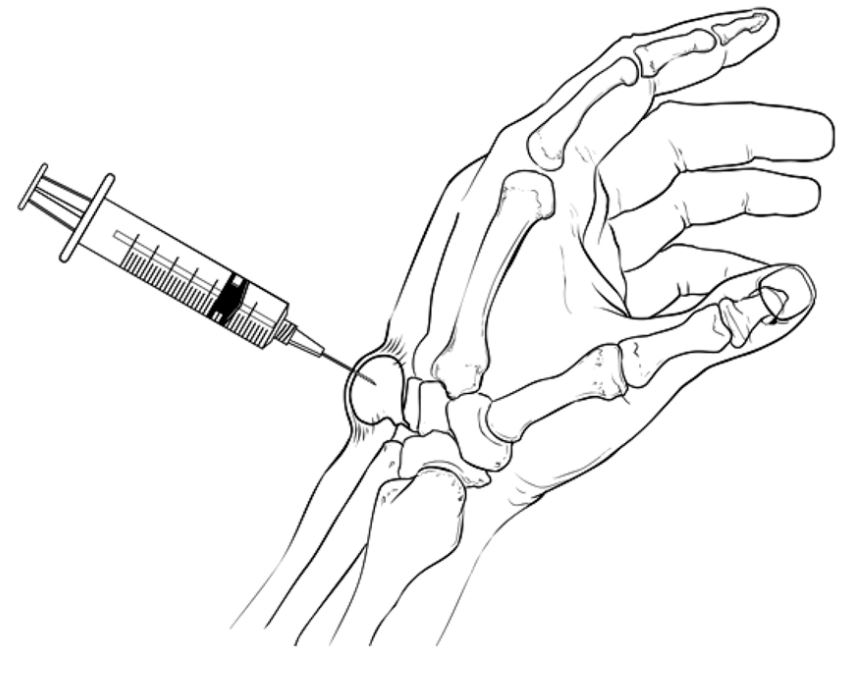
Ganglion Cyst
Whether you are considering a ganglion cyst treatment procedure for yourself or seeking to understand it better for a loved one, this page aims to provide you with valuable insights to make informed decisions about ganglion cyst treatment.
What is a Ganglion Cyst?
Ganglion cysts are fluid-filled sacs that often develop on or near joints and tendons, causing hand and wrist pain and the limitation of movement for those affected. Non-surgical ganglion cyst treatment, such as aspiration or immobilization, can be effective in many cases.
A ganglion cyst is a very common benign mass arising in the hand. These cysts usually arise near a joint or tendon in the hand and wrist. These cysts are often round or oval in shape and can vary in size, ranging from pea-sized to golf ball-sized. Ganglion cysts are filled with a thick, jelly-like fluid, which is found near joints and tendons.
The most common location for ganglion cyst to grow is the back of the wrist (dorsal carpal ganglion). A ganglion cyst can occur in people of all ages and is common in young adults. Ganglion cyst treatment is available at Raleigh Hand to Shoulder Center.

What Causes a Ganglion Cyst?
The cause of a ganglion cyst is unknown in most cases. One theory proposes that the cyst arises from joint fluid that has leaked from a small opening in the joint capsule. The cyst is filled with a thick, jelly-like fluid and usually has a stalk that connects with a joint or tendon sheath. Many patients report that the cyst fluctuates in size, and in some cases the cyst can go away on its own.
While the exact cause of ganglion cysts is not always clear, several factors may contribute to their formation.
Joint or Tendon Irritation
Ganglion cysts often develop near joints and tendons. Inflammation of the joint may lead to irritation, which can trigger the formation of a ganglion cyst.
Joint or Tendon Injury
An injury to a joint or tendon, such as a sprain or trauma, can cause damage to the tissues involved. This damage can lead to the leakage of synovial fluid from the joint or tendon sheath, which may accumulate and form a cyst.
Joint or Tendon Degeneration
Conditions that affect the integrity of joints or tendons, such as osteoarthritis, can increase the likelihood of ganglion cysts. The degeneration of joint or tendon tissues may increase the risk of cyst formation.
Unknown Causes
In some cases, ganglion cysts may develop without an apparent cause. These cysts are often referred to as "idiopathic" ganglion cysts.
How is a Ganglion Cyst Diagnosed?
Most ganglion cysts are diagnosed by history and physical exam by a physician. Since ganglion cysts are fluid-filled, a light shined directly on the mass will trans-illuminate the cyst. Imaging studies such as X-ray, ultrasound, and MRI are not usually required to make the diagnosis in typical cases but can be helpful if the diagnosis is uncertain.

Medical History and Physical Examination
Your doctor will begin by taking a detailed medical history, including any relevant information about your symptoms, their duration, and any prior injuries or conditions. A physical examination will be performed to assess the size, location, and consistency of the lump or mass. Ganglion cysts are often palpable and can be moved slightly beneath the skin. Your doctor may also check for tenderness or pain associated with the cyst.
Aspiration (Optional)
In some cases, your doctor may recommend aspiration, which involves using a sterile syringe to withdraw the fluid from the cyst. This can serve both as a diagnostic and therapeutic procedure, as it may relieve symptoms and confirm the diagnosis.

Imaging Studies (If Needed)
While clinical evaluation and aspiration are often sufficient for diagnosing ganglion cysts, imaging studies such as an x-ray, ultrasound, or MRI may be ordered in cases where the diagnosis is unclear or to assess how close the cyst is to nearby structures.
Ganglion Cyst Surgery
Ganglion cyst surgery is a procedure performed to remove a ganglion cyst when conservative treatments have proven ineffective or when the cyst causes significant wrist pain, hand pain, discomfort, or functional limitations.
Am I a Candidate for Ganglion Cyst Surgery?
Ganglion cysts are not always problematic, and many can be managed without surgery. However, you may be a good candidate for ganglion cyst surgery if you experience the following:
- Persistent pain or discomfort that hinders daily activities.
- Limited joint mobility due to the cyst size or location.
- Cosmetic concerns when the cyst is visible and aesthetically bothersome.
- Failure of non-surgical treatments like aspiration or immobilization to provide lasting relief.
What Does Excision of a Ganglion Cyst Entail?
Ganglion cyst removal surgery is typically performed on an outpatient basis, meaning you can go home the same day. The procedure can be done under local or sedation anesthesia, depending on the cyst's location and surgeon preference.
During surgery, your Raleigh orthopedic hand surgeon makes an incision over the cyst and the cyst is removed. This includes the stalk which tracks down to the joint. Removal of the stalk, or the thin, narrow connection or neck that attaches the cyst to the joint capsule or tendon sheath from which it originates reduces the chance of recurrence, since the root of the problem is addressed.
In some cases, a portion of the joint capsule or tendon sheath may also be removed if it is contributing to cyst formation. The skin incision is then closed with stitches or sutures, and a dressing or bandage is applied.

What is the Recovery Process for Ganglion Cyst Surgery?
Recovery from ganglion cyst surgery is generally straightforward, but it can vary depending on the cyst's size and location, as well as your overall health. You may experience some pain, swelling, and discomfort at the surgical site, which is normal and can usually be managed with pain medications. It is essential to keep the surgical area clean and follow your surgeon's instructions regarding dressing changes and wound care.
Following ganglion cyst surgery, most people can return to light-duty work in a few days as the pain and swelling subside. Occupational therapy is sometimes helpful after this procedure to improve range of motion and strength. Patients should avoid forceful use of the hand for approximately 4-6 weeks after surgery. Normal use of the hand is resumed as comfort allows. There is a 5-10% chance that the cyst comes back after surgery.
What Are the Potential Risks and Benefits of Ganglion Cyst Surgery?
The primary benefit of ganglion cyst surgery is the removal of the cyst, which often provides relief from pain and improves joint function. However, like any surgical procedure, there are risks involved, including infection, scarring, joint stiffness, nerve or blood vessel injury, and the possibility of cyst recurrence.
Your surgeon from Raleigh Hand to Shoulder Center will discuss these risks and benefits with you before the procedure and address any concerns you may have.
What Are the Other Forms of Treatment for Ganglion Cyst?
In the past, some physicians have recommended simply popping the cysts by hitting them with a heavy book or Bible– for this reason ganglion cysts have been called “Bible cysts.” This is not a recommended form of ganglion cyst treatment since damage can be done to the surrounding area and most cysts recur with this technique.
Aside from surgical excision, the other forms of treatment for a ganglion cyst are:
- Observation: Since ganglion cysts are benign (not cancerous), surgery is not required to remove them. Cysts which are not painful and do not interfere with function can be left alone and monitored. If the cyst becomes larger, painful, or interferes with function, surgical options should be discussed.
- Aspiration: The ganglion cyst can be punctured and the thick fluid removed using a needle under sterile conditions. This is a quick procedure which is performed in the office. There is a high chance that the cyst comes back, however. There is a small risk of bleeding, pain, and infection from this procedure.
Schedule Your Ganglion Cyst Evaluation and Treatment in Raleigh
Contact us now to discuss your options and take control of your hand and wrist health. Call us today or book an appointment online!
Updated 6/20/2025

